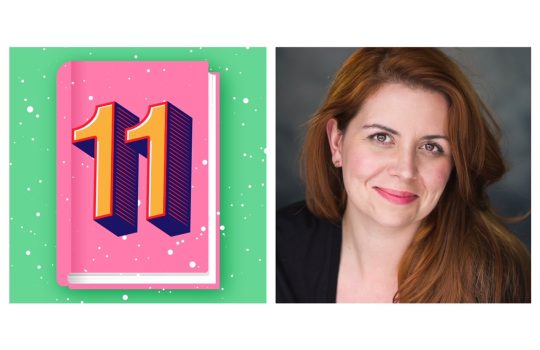It seemed the best place to start was at the very beginning, and that is prologues.
In Elmore Leonard’s famous ten rules for writing, his second rule was: avoid prologues. Which makes everything I’m about to say slightly awkward. “They can be annoying,” he wrote, “A prologue in a novel is back story, and you can drop it in anywhere you want.”
You see, I beg to differ. I am a huge fan of prologues. Why? Because they represent your contract with your reader. What you are stating here, right from the first page – actually, before your first page – is why someone should pick up your book and keep reading. They work beautifully, in my opinion, in both fiction and non-fiction, though I have tended only to use them in my ghosting work until now.
But before I dive into the ins and outs of a prologue, what I want to talk you through is the most perfect one I have seen lately, and that is not in a book, but on the screen. If you haven’t yet seen The White Lotus (Sky/Now TV), you must. I am already on my third viewing of the series, and I never do that. It is a tragi-comedy, set in a plush Hawaiian holiday hotel for the rich (white) elite. We know in fiction that hotels, care homes, aeroplanes, are brilliant little microclimates for letting storylines unfold and characters unravel (maybe microclimates is another blogpost, I’ll keep that one in my back pocket for now) but Mike White, the writer/director of The White Lotus, executes this perfectly.

So the prologue, which is basically his four-minute first scene (and don’t worry, there are no spoilers), opens with a man, sitting alone at an airport, looking pensive, distracted, something on his mind… What? We’re already wondering. Everyone around him is waiting to board a plane two-by-two, all in neat little couples, or families, so what has happened to this guy? Why is he sitting alone? The couple sitting opposite snap him out of his pensive state by asking him if he had a good trip – we’ve all been there having to talk to strangers at airports, plus the wife has this annoying, whiny voice, so we’re already on this guy’s side, we don’t even care who he is. He says he stayed at The White Lotus, to which Annoying Friendly Woman replies that their guide told them someone was killed there. More questions, the plot thickens. He replies that the body is being loaded onto the plane as they speak.
Unperturbed, Annoying Friendly Woman asks: ‘Well, apart from that, did you have a good trip?’ I mean, apart from the dead body in his hotel? Potentially a killer let loose on the breakfast buffet? He replies that he was actually on his honeymoon. Oh? We shuffle a little higher up on our sofa. So where is his wife? And just as we think that, and that horrific little penny starts to drop, the Annoying Friendly Woman – and her husband – say ‘Yeh, where is your wife?’
White is perfect at these awkward moments which, if you keep watching, you’ll see many more of. But the contract he’s already made is this: Someone’s dead, I’m not going to tell you who, you’ll have to work it out, it could be his wife considering this guy was on his honeymoon and now he’s sitting here alone, oh and also, this is going to be a dark comedy, that’s why I’ve stuck this annoying woman right up front just to make that clear to you. White is telling you, if you take this next step with me, this is what you can expect from these next six episodes. And just to make that scene that bit more cringeworthy, Mr Pensive Nice Guy gets up and tells this couple to leave him ‘the fuck alone.’ So now we’re not even sure if we should feel sorry for him (or maybe we like him more) as he strides over to the window and watches the airport staff load a box of human remains onto the plane.
I loved it from that opening scene, and the rest of the series does not disappoint. But see how it works? The prologue serves to hook you in, to pose some questions, to hint at answers, but will they be the same answers as you’re expecting? Or indeed the same questions? You’ll have to continue watching to find out.
I find movies and TV series can be really good inspiration for our writing life, the style of memoir that I ghost is often very filmic in nature and so when I’m writing, I’m letting those scenes unfold in my mind, thinking, if I were a director, where would I be focusing the camera right now, where would I be pulling out….
Back in 2016, I ghosted Hibo Wardere’s memoir CUT: One Woman’s Fight Against FGM in Britain Today. This book had a prologue which was essentially this: girl is woken up in the early hours of the morning by her mother (we sense there is something unusual about this), who feeds her sugary pancakes until her stomach is fit to bursting, bathes her gently with extra care and soapy suds and then leads her into a tent in the garden. That’s all that happens in those three or four thousand words, but look what Eleanor Mills of the Sunday Times wrote in her rave review about it: “I will confess right now that I found the prologue of CUT so agonising to read that it took me three goes to get through it.” And she meant agonising in a good way.
Why? Because, I’ve told you, nothing particularly happens, yet what was buried in all those loving gestures was the unusual nature of them, the suspense, the sense of foreboding, and if your prologue does what it is setting out to do, this is what it needs to suggest. It is a foreshadowing of what’s to come, you can bury all sorts of bodies in there, clues that the reader might only come back to later. In the case of Eleanor Mills, it was obvious from the cover that this was going to be an uncomfortable subject matter. “The contrast between their loving behaviour and the subsequent mutilation is horrendous,” Mills wrote.
And that is what that particular prologue set out to do, and not just for artistic licence but because the issues of FGM is a complex one, as complex as the juxtaposition between those two treatments of the same little girl. That was the contract we were making with the reader: don’t think this is an open and shut case, mothers who have their girls cut think they’re doing it because they love them. That is the horrible truth of the matter.
Prologues don’t have to be long, like this one was, they can be a page, they can be a poem. But what you want to think about is this: what is the function of your prologue? Where is it set in time and space? In the case of The White Lotus, after the scene at the airport, we immediately flashback to ‘one week earlier’ and there our story unfolds. In the case of CUT, the prologue was actually fairly near the beginning of the story, but not right at the beginning. (If that’s the case, when you get to that part of the story, you also want to make sure you don’t go over old ground, you don’t want to be telling your reader something all over again. You don’t want to make Elmore Leonard right.)
Another example of a prologue that works brilliantly, is M L Stedman’s The Light Between Oceans. The story opens on Janus Rock where lightkeeper, Tom, and his wife, Isobel, find a boat washed up on the shore and inside is a dead man and a crying baby. Isobel has miscarried many times, it is clear once more recently, and as she asserts to Tom that this is a gift from God, they ponder between them whether to alert the distant authorities or pass this baby off as their own. We know nothing about this couple and so what they are contemplating sounds horrendous – what if there is a mother, somewhere, looking for her baby? But will we still feel the same when we turn the page and start their story back at the beginning? This book is the only one that has had me crying on public transport by the end, and it works so brilliantly because it poses such a moral question, and then makes the reader complicit in the decision that follows. It forces us to ask, if we were in their place, might we have done the same? And to question, whose side will we be on if it all goes wrong? And all this, started off with a simple prologue.
Anyway, can you see how powerful a prologue can be? In terms of setting up a mystery; of introducing character; of making a political statement; of convincing the reader to collude with the decisions of the characters. Maybe now you can see why I love ‘em. I encourage you to discard everything Elmore Leonard told you about prologues, don’t be afraid of them – give them a go.






